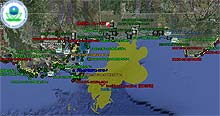EPA Response to BP Spill in the Gulf of Mexico
Air Monitoring
- Data Reports
- Air Sampling
- Real-time Air Monitoring
- learn more ...
|
November 12: EPA releases reports finding levels of dioxins created during controlled burns were below levels of concern. |
||
Dispersants6/30: First Round of Toxicity Testing Data Questions and AnswersWhat You Can DoPhotos of EPA's Response to the BP Spill |
AirMonitoring Air Quality >> The air monitoring conducted to date has not found any pollutants at levels expected to cause long-term harm. With the well capped and no new oil coming into the Gulf, we expect air monitors to continue to show pollution levels that are well below levels of concern. WaterWater Data >> SedimentSediment Data >> Waste ManagementWaste Information >> |
|
Government Response
- RestoreTheGulf.gov: official federal government site for spill response and recovery
Other federal government information:
Connect with us:
Facebook: EPA | Admin. Jackson
Twitter: EPA | Admin. Jackson
Photos: BP Spill | more photos
Get email updates
 EPA data in Google Earth
EPA data in Google Earth
Open the data (.kmz format) in your Google Earth browser.
![]()
- View EPA air, surface water, sediment and waste sampling locations in Google Earth.
Read more. - View ASPECT imagery and air monitoring data (opens in Google Earth)
- If you don't have Google Earth installed on your computer, get the free download here.

